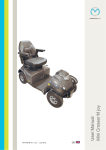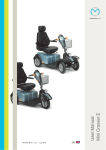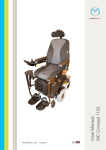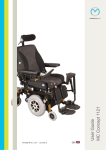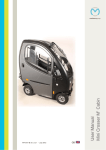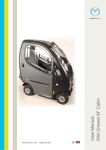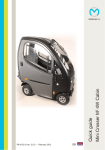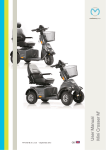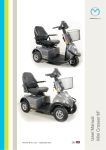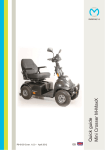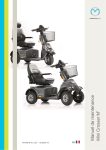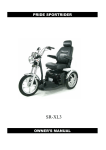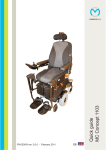Download Medema Mini Crosser M-MaxX User manual
Transcript
User Manual Mini Crosser M-MaxX medemagroup P9-0135-B ver. 1.0.3 - July 2012 GB Medema Production A/S Serial number: ___-______________-______-_______ Delivery date: ________________ Year 20______ This vehicle was supplied by: User guide P9-0135-B Date: 2 of 52 / Version 1.0.3/2012 Medema Production A/S Contents Symbols.................................................................................. 4 Warning! ................................................................................. 4 Contagion!.............................................................................. 4 Introduction............................................................................ 5 Declaration of conformity ..................................................... 6 Control panel ......................................................................... 7 Preparations / Adjustments prior to use ............................. 9 Seat rotation........................................................................... 11 Steering column .................................................................... 12 Serial number......................................................................... 13 Driving the Mini Crosser M-MaxX ....................................... 14 Specific driving situations .................................................... 20 Long hills/difficult ground .................................................... 22 Anti-tilt wheels / stabilisers .................................................. 23 General care and maintenance ............................................ 24 Insurance................................................................................ 25 Batteries ................................................................................. 26 Charging ................................................................................. 26 Battery disposal..................................................................... 28 Storage ................................................................................... 28 Cleaning ................................................................................. 28 Changing the wheels............................................................. 29 Fuses ...................................................................................... 31 Brakes..................................................................................... 32 Disengagement ...................................................................... 32 Towing .................................................................................... 33 Transporting by motor vehicle ............................................. 34 Transporting by plane ........................................................... 34 Securing to vehicle floor with belts ..................................... 35 Dimensioned drawing, Mini Crosser M-MaxX 4W .............. 37 Introduction to seats - Ergo Standard ................................. 38 Introduction to seats - Mando .............................................. 40 Troubleshooting .................................................................... 41 Programming ......................................................................... 44 Technical data ........................................................................ 44 Own notes .............................................................................. 47 International addresses ........................................................ 48 User guide P9-0135-B 3 of 52 Version 1.0.3/2012 Medema Production A/S Symbols Used in the manual to indicate sections describing situations where extra care is required owing to the risk of personal injury. Used to indicate sections on electromagnetic compatibility (EMC). Warning! The Mini Crosser M-MaxX is a powerful vehicle, equipped with 2 motors. One on each rear wheel. Therefore, careful training on the use of the vehicle is required. For safety reasons the vehicle must not be lent to persons who are not completely familiar with it. The vehicle is designed for one person only. The Mini Crosser M-MaxX has been designed for users weighing max. 250 kg. Contagion! Note! The tires can sometimes rub off on floor coverings, particularly linoleum. Medema Production assumes no responsibility in case of contagion. To prevent this, we recommend that you protect delicate floors with some sort of driving surface. User guide P9-0135-B 4 of 52 Version 1.0.3/2012 Medema Production A/S Introduction Congratulations on your new Mini Crosser M-MaxX electric mobility scooter. You have now taken possession of an electric mobility scooter developed for outdoor driving by active users. It is what is called a Class C vehicle in accordance with the European classification of electric scooters. For optimum enjoyment of this vehicle - and to avoid breakdowns and accidents - we recommend that you read this User Manual carefully. As a new user, you should pay particular attention to the section entitled “Driving the Mini Crosser M-MaxX”. The Mini Crosser M-MaxX is designed for safe travel for at least 10 years, up to a max. of 5,000 hours, provided it is serviced and safety-checked every year, corresponding to 500 hours of operation. The service must be carried out by an authorised workshop. IMPORTANT! For safety reasons it is of the utmost importance that service and safety check intervals are complied with, as this minimises the risk of brake failure and short-circuits in the wiring, which could generate heat and cause a fire. We offer a wide range of accessories for the Mini Crosser M-MaxX that can make everyday life easier for you. You are always welcome to contact us for further information on special accessories and adaptations. Medema Production A/S is not responsible for any damage or injuries caused by inappropriate or unsafe use of the Mini Crosser M-MaxX. If you have any further questions about the Mini Crosser M-MaxX or this User Manual, you are always welcome to get in touch. Our contact details are as follows: Medema Production A/S Tel: +45 7010 2054 Email: [email protected] Internet: www.medema.com NB: Errors and omissions excepted. We reserve the right to update this manual as required. User guide P9-0135-B 5 of 52 Version 1.0.3/2012 Medema Production A/S Declaration of conformity Medema Production A/S hereby declares that: Machine: Mini Crosser Use: (Prescribed use in User Manual) Model No: M-MaxX Complies with the Medical Device Directive 93/42/EEC The product is made in accordance with the harmonized standard EN 12184 - Electrically powered wheelchairs, scooters and their chargers. The product is risk analysed in accordance with the harmonized standard DS/EN ISO 14971:2007-04-10 2. edition - Medical devices - Application of risk management to medical devices. The Mini Crosser can, for a fee, be taken to the nearest dealer for disposal in accordance with current environmental regulations. User guide P9-0135-B Manufacturer: Medema Production A/S Address: Enggårdvej 7, DK-7400 Herning Tel./Fax +45 7010 2054 +45 9716 8582 Date: 12.04.2010 Signature: _____________________ 6 of 52 Version 1.0.3/2012 Medema Production A/S Control panel Avoid subjecting the control panel to jarring and knocks. Take care when driving and avoid hitting obstacles. The manufacturer accepts no liability in respect of the unauthorised opening, adjustment or modification of the control panel. Hazard warning lights Light switch High/low switch Indicator lights, R/L Indicator lights, R/L Horn Speed selector Horn Accelerator (four-finger control) Lever for adjusting the angle of the handlebars Charging socket Battery indicator Key switch User guide P9-0135-B 7 of 52 Version 1.0.3/2012 Medema Production A/S Designation Description Key switch To start the vehicle: Turn the key to driving position (1) When the Mini Crosser is turned on, the control system performs a safety check of the electrical system. The check lasts half a second. If the accelerator is operated during this time, the Mini Crosser will not be able to move until you have turned the key to 0 and back to 1. Speed selector The tortoise in minimum position indicates the lowest speed range. 0-6 km/h The hare in maximum position indicates the highest speed range. Up to 11,5 km/h Battery indicator Lights up when the key is turned. After approximately 1 second, indicates the batteries’ charge level. Provides a more accurate indication after a few minutes driving. This is not an exact measurement and you must therefore build up some experience with it. In the same way as the petrol gauge on a car. When the red light is farthest from “1”, there is plenty of power in the batteries. When the red light is farthest from “0” and flashing, it is close to being completely discharged. Accelerator Activate the arm at the front slowly and the Mini Crosser will start to move forwards. The more the arm is pressed, the faster the Mini Crosser will move. When the arm is released, it will flip back to starting position of its own accord and the Mini Crosser will stop. Activating the rear arm will cause the Mini Crosser to reverse. The magnetic brake on the rear wheels will engage when the scooter is stationary and is equivalent to the parking brake on a car. The accelerator can also be used to control speed downhill. In this case the motor will act as a brake. (See picture below) Light switch Turns on the front and rear lights. The key switch must be in position 1 (driving position). Hazard warning lights Turns on all the indicator lights at once. Also works when the key is removed or turned to position 0 (stop position). Indicator switch Left arrow: indicator, left-hand side. Right arrow: indicator, righthand side. Activate the same switch to turn the indicators off. Horn Powerful electric horn. Press the horn switch to activate. Charging socket Turn off the key switch during charging. Please note that it is not possible to drive the scooter while the batteries are charging. See also the section entitled “Batteries and charging”. High/low switch Switch between high and low max speed. Accelerator (four-finger control) User guide P9-0135-B 8 of 52 Version 1.0.3/2012 Medema Production A/S Preparations / Adjustments prior to use Adjusting the height of the seat Lift the seat off and remove the rear cover. Press the release button out and adjust the seat tube to the desired position. See the picture on the next page. Check that the seat height is correct and press the release button in again. Move the seat tube up/down until the release clicks into a hole. Make sure you keep your back straight when lifting the seat, which is very heavy. (See below.) Lift the seat off the seat tube. The release button pressed in. Press the button out to release the seat tube. User guide P9-0135-B 9 of 52 Release button pressed out. Now the seat tube can be moved up/down to the height you wish. Press the release button again and make sure it is fitted in one of the 5 holes in the seat tube. Version 1.0.3/2012 Medema Production A/S Seat tube Release Seat tube in top position. There are five holes for adjusting the seat tube. The release must be in a hole for the seat to be stable. User guide P9-0135-B 10 of 52 Version 1.0.3/2012 Medema Production A/S Seat rotation Pull the release lever back. The seat can be rotated 90° to either side. When the lever is released, it engages with the seat and holds it in place at 45° intervals. Other seats that can be supplied for the Mini Crosser work on similar principles. The release lever is normally mounted on the right, but can be put on the left if so wished. Release lever for seat rotation. Release lever for seat forward/back. User guide P9-0135-B 11 of 52 Version 1.0.3/2012 Medema Production A/S Steering column Can be adjusted forward/back with the release lever. Pull down on the lever and pull the handlebars closer for a good driving position. Use the lever again and push the steering column forward to make it easier to get out. The height of the steering column can be adjusted approx. 11 cm up/down. First remove the rubber plug covering the Allen screw. Adjust the height using a 4 mm Allen key. Adjusting the angle of the handlebars. Lever for adjusting the angle of the handlebars Adjusting the height of the handlebars. Allen screw for height adjustment User guide P9-0135-B 12 of 52 Version 1.0.3/2012 Medema Production A/S Serial number All vehicles have a serial number plate showing the year of production and serial number. The same serial number can also be found on the front of the User Manual. Please quote this number when making inquiries about servicing, spare parts, etc. Maximum user weight Model description Vehicle’s unladen weight inc. batteries and seat Serial number Year of production Max. speed Position of serial number plate on vehicle. User guide P9-0135-B 13 of 52 Version 1.0.3/2012 Medema Production A/S Driving the Mini Crosser M-MaxX Getting in and out It is important to learn a safe technique for getting in and out of the Mini Crosser. In general the following method should be followed: • • • • • Make sure that the Mini Crosser M-MaxX is off (switch turned to 0) when getting in and out, otherwise the Mini Crosser could start if the accelerator was touched inadvertently. Make sure that the brake is on. (Lever for disengaging motor in top position.) Put the steering column in vertical position. If necessary, turn the seat through 45° or 90° and make sure that it is locked in position (clicked into place). If necessary, raise the armrest. For some users the assistance of an attendant can be recommended. The attendant should: • • • Take care not to injure him/herself when lifting/lowering/supporting the user. Make sure that the Mini Crosser is stable and unable to move. Turn off the Mini Crosser and check that the brake is on and the seat has been rotated until it clicks into place at either 45° or 90°. Make sure that the seat the user is being moved to is stable. IMPORTANT! The Mini Crosser will turn itself off automatically after it has been stationary for 10 minutes even if the key has been turned to driving position. To restart the vehicle, the key must be turned to stop position (0) and then to driving position (1). User guide P9-0135-B 14 of 52 Turn the Mini Crosser off, return the steering column to upright position, rotate the seat and raise the armrest. Version 1.0.3/2012 Medema Production A/S Braking systems There are three braking systems on the Mini Crosser: • Motor brake - adjusts vehicle speed also when going downhill. • Magnetic brake - the magnetic brake is automatic and engages when the Mini Crosser stops. In an emergency, the Mini Crosser can be stopped instantaneously by turning the key switch. Please note that this will cause very sharp braking. The rear wheels will lock. Must NOT be used in the normal course of driving. The brake must never be disengaged mechanically using the disengagement lever on a slope. This function is only designed for use when pushing the Mini Crosser on a flat road. General safety advice Make sure that the backrest is upright and the seat is as low as possible. Positioning belts are recommended if the user is unable to maintain a good driving posture independently. Adjust your driving to road conditions. Take account of light, traffic and weather. Be particularly careful when driving in the dark or in bad weather, such as rain or snow. Avoid driving on gradients with poor surfaces, such as: snow, ice, new-mown grass, wet grass and wet leaves. User guide P9-0135-B 15 of 52 Version 1.0.3/2012 Medema Production A/S Never drive when under the influence. This applies not only to alcohol, but also to drugs and medicines. Reduce speed immediately if you feel you are losing control. Always use the indicators when changing direction. Check that lights and indicators are working before driving off. Use your lights when driving after lighting-up time. As far as possible, grip the handlebars firmly with both hands. Take care not to have anything in the basket at the front that might inadvertently operate the accelerator. WARNING! Do not lower the handlebars so far that the accelerator can hit you on the leg when you turn the vehicle and so be operated in advertently. If the handlebars need to be very low, a twist grip accelerator is recommended. This is particularly relevant if leg supports are being used. ALWAYS switch the scooter off when it is not in use. Turn the key to 0. Driving Even though the Mini Crosser is very stable, it can tip over. Avoid sudden changes of speed and direction when travelling at high speed, on poor surfaces and, not least, on slopes. For short distances the Mini Crosser can drive up steeper gradients than it has been tested as dynamically stable for. The same applies to driving down such gradients. In such cases there is an increased risk of the Mini Crosser tilting and even tipping over. So be extra careful in following the driving tips given below. Anti-tilt wheels are recommended for driving in very hilly terrain. (Optional extra) User guide P9-0135-B 16 of 52 Version 1.0.3/2012 Medema Production A/S New users are urged to practise the following in an area where there is no other traffic: • Set the Mini Crosser to low speed. Drive forwards and backwards. Gradually turn the speed selector up and feel the change in the speed of the Mini Crosser. • Practise starting and braking. Get used to the Mini Crosser’s response time. • Practise driving in a narrow space, similar to inside a shop or through a door. • Practise turning, and get a sense of how much space is required. Always drive slowly when turning. Practise reversing too. • Practise cornering and driving over obstacles and on slopes. Always drive straight up/down kerbs and ramps. Never at an angle. See the illustrations on the following pages. • Try braking at different speeds and notice the stopping distances. • If possible, try driving on different surfaces (road, grass and gravel). • Practise assessing how far you can drive on a single battery charge. Note how quickly the battery indicator changes from green to amber to red. Note! The driving distance of the scooter will be reduced when driving in hilly districts, into a head wind, in cold weather and with low tyre pressure. User guide P9-0135-B 17 of 52 Version 1.0.3/2012 Medema Production A/S Traffic regulations The traffic legislation for scooters varies from country to country. Before starting to use the vehicle outdoors, it is the user’s responsibility to familiarise him/herself with the relevant legislation. The following rules apply in Denmark: Mobility vehicles such as the Mini Crosser with a maximum speed of up to 11.5 km/h count as cycles in traffic legislation and the traffic regulations for cycles must be followed at speeds in excess of 6 km/h. At speeds of up to 6 km/h the Mini Crosser is regarded as a “pedestrian”, and it is permissible to travel on the pavement at this speed. “Tortoise” speed corresponds to approx. 6 km/h. Lights must only be used during lighting-up time. Crash helmet and seat belts are not compulsory. User guide P9-0135-B 18 of 52 Version 1.0.3/2012 Medema Production A/S Electromagnetic compatibility If the Mini Crosser starts making involuntary movements or if the brakes are released, turn the Mini Crosser off as soon as it is safe to do so. In certain circumstances a Mini Crosser can set off shop alarms. The Mini Crosser satisfies the requirements for the use of scooters in an environment with electromagnetic noise. There may, however, be rare situations in which electromagnetic noise can affect the Mini Crosser. Sources of such noise include radio and television stations, amateur radio transmitters and mobile phones. If such equipment is being used close by, it is recommended that the Mini Crosser is switched off. Mobile phones should not be used while driving. When driving in traffic... Be particularly aware of the following when driving in traffic: User guide P9-0135-B • The Mini Crosser is a low vehicle and not always easy for other road users to see. Make quite sure that other road users have seen you before driving onto the highway. • Keep an eye on traffic behind you. Keep well over to the side of the road when driving on busy roads. • Turning right and left at crossroads. Be aware of cyclists and pedestrians. Follow the rules of the road for cyclists. • How quickly things are happening. How long do the lights stay green? How quickly are cars approaching? etc. 19 of 52 Version 1.0.3/2012 Medema Production A/S Specific driving situations Up kerbs • • • • Stop at right angles to the kerbstone about 5-10 cm away from it. Keep an eye on other road users. Lean forwards. Accelerate moderately so that your vehicle can overcome the obstacle. Do not stop halfway, but reduce speed once the vehicle is up. If the kerb is too high, do not try again, but find an alternative route. Down kerbs • • • User guide P9-0135-B Lean back. If you are driving onto a road with traffic, keep an eye on other road users. Drive forwards and down the kerb at low speed. Make sure that your anti-tilt wheels (if fitted) do not catch on the edge. 20 of 52 Version 1.0.3/2012 Medema Production A/S Up a ramp/hill • • • • There is a risk of tipping over backwards if the seat is pushed back when you start driving up a slope, e.g. a ramp. Pull the seat forward! Check that any ramp is stable. Lean forwards. Accelerate moderately so that your vehicle can overcome the obstacle. Do not stop halfway. Reduce speed once the vehicle is up. If you need to start on a hill, accelerate slowly so as not to tip over backwards. Down a ramp/hill • • • User guide P9-0135-B Check that any ramp is stable. Lean back. Drive slowly down. Avoid stopping midway on short, steep slopes. On long hills, it is advisable to stop every now and again if you feel your speed is getting too high. 21 of 52 Version 1.0.3/2012 Medema Production A/S Across a slope • • • Lean into the slope. Avoid sudden and sharp movements. This is particularly relevant when reversing. Always drive at low speed. Long hills/difficult ground The Mini Crosser is at risk of overheating on very long and steep hills or on very soft ground, possibly also combined with high user weight. To protect your Mini Crosser’s motor from overheating, there is a built-in Thermo switch that will make the Mini Crosser stop if the motors become too hot. The battery indicator will flash. Next, the Mini Crosser must cool for 3 to 5 minutes, before it can run again. Note: The situation described above will never happen in normal use. It only happens if the conditions are extremely challenging. User guide P9-0135-B 22 of 52 Version 1.0.3/2012 Medema Production A/S Anti-tilt wheels / stabilisers The Mini Crosser is a very stable vehicle. HOWEVER, in the case of incorrect weight distribution or careless driving there is a risk of tipping over. We therefore recommend fitting anti-tilt wheels in such circumstances. (See picture below) (Anti-tilt wheels / stabilisers are optional extras.) Anti-tilt wheels User guide P9-0135-B 23 of 52 Version 1.0.3/2012 Medema Production A/S General care and maintenance A Mini Crosser M-MaxX does not require much maintenance. It should be kept in a generally good condition, however. The following should be checked regularly: • • • • Tyre pressure (if pneumatic tyres are fitted) Tyre wear Keep the control panel, the charging socket and the electronics box under the seat dry. Battery charging Never wash the Mini Crosser with a high-pressure cleaner or direct water jet! This could damage the Mini Crosser’s electronics. To keep the Mini Crosser in good condition safety-wise, we recommend the following regular checks: Daily: • Test the indicators and driving lights before using the Mini Crosser in the dark or poor visibility. Every three months: Test the brakes and motor disengagement With the disengagement lever up, it must not be possible to push the Mini Crosser. Test the brake disengagement function When the brake disengagement lever is down, the battery indicator should flash to show an error if the Mini Crosser is turned on. In this case the Mini Crosser must not be able to move when the accelerator is activated. Test the electrical release mechanism. Test that the Mini Crosser can be pushed when the electrical release button is held. When the button is released, it can no longer be pushed. Lubricate the lever arm on the brake hub with acid-free oil - lefthand rear wheel. User guide P9-0135-B 24 of 52 Version 1.0.3/2012 Medema Production A/S Annual The Mini Crosser M-MaxX is designed for safe travel for at least 10 years, up to a max. of 5,000 hours, provided it is serviced and safety-checked every year, corresponding to 500 hours of operation. The service must be carried out by an authorised workshop. IMPORTANT! For safety reasons it is of the utmost importance that the servicing and safety check intervals are complied with, as this minimises the risk of brake failure and short-circuits in the wiring, which could generate heat and cause a fire. (For further information see the Service Manual.) Insurance In the eyes of the law a Mini Crosser M-MaxX with a maximum speed of 11.5 km/h is a cycle, so separate insurance is not required. Most contents/home insurance policies include third-party liability insurance for cyclists and so also cover Mini Crosser M-MaxX users. We recommend that you talk to your insurance company about this when the vehicle is delivered. If necessary, comprehensive insurance will have to be taken out separately. User guide P9-0135-B 25 of 52 Version 1.0.3/2012 Medema Production A/S Batteries The Mini Crosser uses sealed, maintenance-free GEL batteries (Exide 12 V/56 Ah or AGM 12 V/71 Ah). They do not generate gas and do not have to be topped up with water. Charging Please NOTE that the Mini Crosser can be equipped with several types of charger (ask your dealer for information on the various types). IMPORTANT! Only ever use a charger designed for charging dry maintenance-free batteries. The max. charging current is 12 A. If charging is to take place outdoors, an enclosed charger without a fan should be chosen. The battery manufacturer recommends charging the batteries at temperatures between +10° and +30°C in order to achieve the charging times specified in “Technical data”. Charging will take longer at temperatures below +20°C. This is because the battery finds it more difficult chemically to absorb the current. Please NOTE that the capacity of the batteries will reduce over time and at low temperatures. In practice this means that vehicles with old batteries have a shorter driving distance than they had when the batteries were new. Battery capacity at -10°C is about half the equivalent capacity at +20°C. Det anbefales at batterierne lades op hver nat, hvis scooteren har været benyttet. User guide P9-0135-B 26 of 52 Version 1.0.3/2012 Medema Production A/S Avoid draining the batteries completely. We recommend charging the batteries in a heated room. If it is not possible to do this every day, it is a good idea to charge the Mini Crosser in a heated room (approx. 20°C) once a week. New batteries do not reach full capacity until they have been charged and discharged about 20 times. It is IMPORTANT to fit the batteries correctly. The battery terminals and snap locks are marked +/-. They must be fitted as shown in the sketch below. Make sure that the snap locks are properly closed. For the same reason there must not be any burrs on the terminals. The Mini Crosser should be charged while not in use. The charger supplied from the factory switches over to trickle charging (very low power consumption) automatically when the batteries are fully charged. You can therefore leave the charger connected until the Mini Crosser is next used. The charger cannot overcharge the batteries. The charger will flash until charging is complete. Then it will show a steady light. The charger must not be placed on the seat during charging. IMPORTANT! Never use charging devices other than those supplied from the factory without first contacting the dealer. NEUTRIK NC3MX charging plug User guide P9-0135-B 27 of 52 Connect the charging plug to the 3-pin socket on the steering column. The charging socket is located under the protective cover. Version 1.0.3/2012 Medema Production A/S Battery disposal Used batteries must be disposed of through your supplier or at a recycling centre. Take care when handling leaky batteries, as the gel contains corrosive acid. INFO! New batteries can be purchased from Medema Danmark A/S. Storage The scooter should be stored and charged under cover, preferably at temperatures above 0°C. Note! The charger must be kept dry, but should not be covered when in use. In the case of long-term storage we recommend covering the Mini Crosser M to protect it from dust, rain and sunlight. Cleaning Clean the Mini Crosser M-MaxX with a damp cloth. If necessary, wipe dry with a chamois leather. Wipe the covers dry and polish with car wax. IMPORTANT! Never use a high-pressure cleaner or hose, as it could damage the Mini Crosser’s electronics. User guide P9-0135-B 28 of 52 Version 1.0.3/2012 Medema Production A/S Changing the wheels If you get a puncture in one of the pneumatic tyres or if a tyre is so badly worn that it needs to be replaced, follow the instructions below. Tyres and inner tubes can be purchased from the authorised dealer who supplied the Mini Crosser. The Mini Crosser must be TURNED OFF before you start. Changing the wheels on the 4W model 5 mm Allen key • • • Undo the five bolts. Take the wheel off. When the wheel is put back on, the spring washers must be refitted between the wheel rim and bolts. The bolts must be done up tightly. Remove the valve cap and use a screwdriver, or similar, to open the valve so that the air can be released. REMEMBER! • • User guide P9-0135-B to let all the air out before taking the wheel apart to repair a puncture to secure the bolts with spring washers 29 of 52 There is a risk of bursting the wheel rim if the two rim halves are separated while there is air in the tyre. Version 1.0.3/2012 Medema Production A/S Remove the flange with the 5 screws (5mm Allen). Replace or patch the tube. Ensure that there are no foreign objects in the tyre before the tube is replaced. Pump in a little air but do not fill it up yet. Replace the flange. Pump up the wheel to the correct pressure. (See technical data) Fit the wheel onto the Mini Crosser again. REMEMBER! The spring washers between the screws and the wheel rim. User guide P9-0135-B 30 of 52 Version 1.0.3/2012 Medema Production A/S Fuses The Mini Crosser has the following protection systems: • Automatic overload protection, which limits the current to the motor. This protection is integral to the control system and cannot be adjusted. It prevents both the control system and the motor from being overloaded. In the event of overload the current to the motor is reduced - full speed and traction can be resumed after the motor has cooled down for 2-5 minutes. • The control fuse protects against mains faults. It is located under the rear cover. • The main fuse protects against short-circuits in the main current circuit. The fuses are located under the rear cover behind the batteries. Fuse type DIN 2581 - 150a. • If the ignition key is turned at the same time as the accelerator is operated, the vehicle will not move off for safety reasons. • The lights and horn are protected by electronic fuses, which protect against any short-circuiting that may occur. To prevent accidental short-circuiting when a bulb is changed, the Mini Crosser must be turned off when the new bulb is fitted and then turned on again afterwards. 1 2 3 4 1. Fuse 40A - charges 2. Fuse 10A - power 3. Extra fuse 10A - not used 4. Extra fuse 10A - not used User guide P9-0135-B 31 of 52 Main fuse 150 A. Located on each page under the battery cover, behind the batteries. Version 1.0.3/2012 Medema Production A/S Brakes There are three braking systems on the Mini Crosser M: • • Motor brake Magnetic brake • Motor brake: adjusts vehicle speed also when going downhill. • Magnetic brake: automatic and comes on when accelerator is released. It also acts as a parking brake when the Mini Crosser is at a standstill. In an emergency, the Mini Crosser can be stopped instantaneously by turning the key switch. Please note that this will cause very sharp braking. The rear wheels will lock! Must not be used in the normal course of driving! Disengagement There is two ways to disengage the M-MaxX. Mechanical and electrical. Mechanical release • Push the disengagement lever at the back down. The motor brake is now disengaged and the vehicle can be pushed or towed, but not driven. Push the disengagement lever up to disengage and push down to reactivate the motor (normal driving now possible). Disengagement lever pushed down User guide P9-0135-B 32 of 52 Version 1.0.3/2012 Medema Production A/S Disengagement lever pushed up Electrical release • Hold the disengagement button pressed in to disengage (can be pushed or towed with max 5 km/h – see section about Towing). As soon as you let go of the disengagement button, the motor brake is working again (normal driving now possible). Disengagement button NOTE! The motor brake must never be disengaged on sloping terrain. Towing If you should be unfortunate enough to break down, the Mini Crosser can be towed or pushed. The Mini Crosser must always be turned off and the motor brake disengaged during towing. See the section on Brakes. If the Mini Crosser is to be towed, secure a rope to the tow fi tting on the front - marked with a yellow “hook mark”. Do not tow faster than 5 km/h. The scooter will generate electricity when it is towed, with the motor acting as a dynamo. If it is towed at more than 5 km/h, there is a risk of the motor generating enough electricity to damage the scooter and, in the worst case, cause a fire. User guide P9-0135-B 33 of 52 Version 1.0.3/2012 Medema Production A/S Transporting by motor vehicle The Mini Crosser must always be restrained during transport in a motor vehicle or trailer. Avoid lifting by the seat, covers, handlebars and armrests If you just need to lift the scooter slightly, take hold of it between the rear lights and by the front bumper. Secure it in the vehicle with belts attached to the two eyes at the front and two at the back. All the eyes are marked in yellow. See the section entitled “Securing to vehicle floor with belts”. Transporting by plane If the Mini Crosser is to be transported by plane, the airlines require: • • • the batteries to be flight-approved the air to be let out of the tyres the battery leads to be disconnected (not always, but frequently) The seat and cover have to be removed to disconnect the battery leads. A battery declaration for air travel can be found on the Mini Crosser website: http://www.minicrosser.dk/Download_brochurer.asp For transport in an estate car, the seat can be lifted off and the handlebars folded down. This reduces the maximum height to 70 cm. User guide P9-0135-B 34 of 52 Version 1.0.3/2012 Medema Production A/S Securing to vehicle floor with belts Dahl Engineering belt set for securing in motor vehicles. Item No. C2-0242 ALWAYS use four belts at the back and two at the front. The belts must always be attached to approved fittings in the vehicle and the four eyes welded to the scooter. The belts MUST be attached within the angles shown in the picture for optimum security. 45˚ User guide P9-0135-B 45˚ 35 of 52 Version 1.0.3/2012 Medema Production A/S Attachment point Attachment point Greater than the anchorage points on the scooter Centre line User guide P9-0135-B 36 of 52 Greater than the anchorage points on the scooter Version 1.0.3/2012 Medema Production A/S 1075 mm Dimensioned drawing, Mini Crosser M-MaxX 4W 650 mm 175 mm 135 mm 520 mm M2+: 290 mm 1030 mm 1500 mm User guide P9-0135-B 526 mm 680 mm 1620 mm 37 of 52 Version 1.0.3/2012 Medema Production A/S Introduction to seats - Ergo Standard Lever for seat rotation Pull the lever back to release the seat. The seat can then be turned 90° to either side with a stop every 45°. The lever is spring-loaded and the seat locks automatically when the lever is released. This lever is located on the right as standard, but can also be put on the left. Lever for seat forward/back Pull the lever out/up to release the seat on the slide rail. The seat can then be moved forward or back as required. When the lever is released, the seat automatically locks at the nearest stop. There is a chock block on the front and back of the slide rail. Adjusting the angle of the armrest The adjusting screw makes it possible to alter the angle of the armrest by about 15°. The arm can be folded right up to make it easier to get in and out. (Height adjustment of the armrest is an optional extra.) User guide P9-0135-B 38 of 52 Version 1.0.3/2012 Medema Production A/S Adjusting the angle of the backrest The angle of the backrest can be adjusted by about 30°. This can be done by undoing the adjusting screw and changing the position of the spacer. Do the screw up again after making the adjustment. Optional extra: The seat can be fitted with a gas cylinder for adjusting the angle of the backrest. Armrest forward / back: The armrest can be moved forward / back on the C-rail. This can be done by undoing the screws indicated. Do the screws up again after making the adjustment. Backrest forward / back: The depth of the seat can be adjusted. This can be done by moving the backrest forward and back while the seat cushion is held in position. Undo the screws indicated on both sides. The backrest can then be moved as far back as the edge of the rail and about 15 cm forward. Do the screws up after making the adjustment. The screws must be at least 2 cm from the end of the C-rail. User guide P9-0135-B 39 of 52 Version 1.0.3/2012 Medema Production A/S Introduction to seats - Mando Adjusting the angle of the backrest: The angle of the backrest can be adjusted by about 30° by raising this lever. Adjusting the angle of the armrest: The angle of the armrest can be adjusted by turning this screw. Adjusting the height of the armrest: The armrest can be raised/ lowered by undoing the two screws and moving the bracket one hole up or down. Headrest: The headrest can be raised and lowered steplessly. User guide P9-0135-B 40 of 52 Version 1.0.3/2012 Medema Production A/S Troubleshooting The following is a list of various problems that, in our experience, may occur. The list gives possible causes and remedies. Problem Possible causes Remedy The Mini Crosser will not go. The key has not been turned to start. The battery indicator is not lit. Turn the key and wait 5 sec. before activating the accelerator. Charge the batteries. The batteries are completely flat. The control fuse has blown. Change the fuse. The main fuses have blown. Contact supplier. The Mini Crosser will not go, but the battery indicator is lit. The Mini Crosser has been overloaded. Wait approx. 1 min. before trying again. The vehicle must be turned off (see section on Fuses). Contact supplier. There is a fault in the electronics. The batteries are flat. Contact supplier. The charging plug has not Remove the charging been removed. plug. The driving speed is too low. The driving distance per charge is too short. The speed selector is on slow. The electronics are overloaded. There is too little air in the tyres. Change to a faster speed. There is a problem with the batteries. Low temperature. Charge the batteries and check that the green lamp on the charger lights up before driving off. Contact supplier. There is a problem with the charger. There is too little air in the tyres. The charging method is wrong. User guide P9-0135-B Stop and wait a few seconds before starting. Pump the tyres up to the right pressure. Pump the tyres up to the right pressure. Read the section on Charging in the User Manual. The charging lamp on the charger does not light up when the charger is connected to the mains and the Mini Crosser. No power to the switch. Fault in cable. Fault in charger. Turn the switch on. Contact supplier. Read the operating instructions for the charger. Contact supplier. The “ready” lamp on the charger does not light up even though the charger has been on for 10-12 hours. There has been a power cut. Reconnect the charger and repeat the charging process. Check again half an hour later. Contact supplier. The charger is doing a top-up charge. There is a problem with the batteries. There is a fault in the charging plug for the Mini Crosser M-MaxX. 41 of 52 Push the charging plug all the way in and repeat the charging process. Read the operating instructions for the charger. Version 1.0.3/2012 Medema Production A/S Problem Possible causes Remedy The “ready” lamp on the charger lights up even when partly discharged batteries are connected. Contact supplier. The fuse in the charger has blown. The switch in the charging Contact suppliers - read plug is malfunctioning. the operating instructions for the charger. The charger lamp is showing an error. The charging plug has not been inserted or there is a mains fault. The battery voltage is too low for charging to start. Push the charger plug in or contact the supplier. Read the operating instructions for the charger - or contact the supplier. The table below indicates the fault types which the battery indicator can display in the case of an electronic fault on the Mini Crosser. Count these and read off in the table what kind of fault they indicate. However, it is recommended that you can quote the number of the flash code when contacting the supplier. LED CODE PROGRAMMING EXPLANATION LCD DISPLAY POSSIBLE CAUSE 1,1 HARDWARE FAILSAFE 2 Loss of power 1. Short circuit in motor or motor cable 2. Failure of control unit HARDWARE FAILSAFE 4 Overcurrent fault HARDWARE FAILSAFE 1 EEPROM fault 1. Fault in or failure of EEPROM HARDWARE FAILSAFE 3 Main contactor fault 1. Main contactor welded 2. Fault in driver in main contactor 3. Fault in coil in main contactor 1,2 1. Short circuit in motor or motor cable 2. Failure of control unit Precharge fault PRECHARGE FAULT Motor voltage fault HW FAILSAFE 1. Fault in internal control unit 2. Low battery voltage 1. Motor voltage does not fulfil throttle requirements. 2. M1 or M2 power shortcircuited to B- or B+. 3. Internal motor short circuit. 4. Failure of control unit 2,1 User guide P9-0135-B SRO SRO fault 42 of 52 1. Wrong sequence of KSI, power activation and input data for direction 2. Selection of wrong SRO type 3. Direction switch circuit open Version 1.0.3/2012 Medema Production A/S 2,2 HPD HPD fault 1. Wrong sequence of KSI, power activation and input data for throttle 2. Wrongly set potentiometer for throttle 2,3 PROC/WIRING FAULT HPD fault displayed for >5 sec. 1. Wrongly set throttle 2. Potentiometer for throttle defective 3. Throttle mechanism defective 2,4 SPD LIMIT POT FAULT Fault in speed limit potentiometer 1. Wiper cable for speed limit potentiometer defective 2. Speed limit potentiometer defective 3,1 BB WIRING CHECK Fault in emergency return cable 1. BB cable open 2. BB check cable open 3,2 EM BRAKE DRVR FAULT Driver fault in electromag. brake 1. Coil on electromagnetic brake short-circuited or open 2. Cable for electromagnetic brake open 3,3 THROTTLE FAULT 1 Fault in throttle 1. Input wire for throttle open 2. Short circuit of input wire for throttle til B+ or B3. Defectective throttle potentiometer 4. Wrong choice of throttle type 4,1 LOW BATTERY VOLTAGE Low battery voltage 1. Battery voltage <16 V (24V models), <21V (36V-models) or <27V (48V-models) 2. Corroded or loose battery clamp 3. Loose clamp on control unit 4,2 OVERVOLTAGE Overvoltage 1. Battery voltage >36 V (24V models), >48V (36V-models) or >60V (48V-models) 2. Vehicle in use with charger connected 4,3 THERMAL CUTBACK Over/undertemperature cutback 1. Temperature >95 ºC or <-25 ºC 2. Overload on vehicle 3. Wrong installation of control unit 4. Operation under extreme conditions Example 1: Fault 1,1 means that the battery indicator flashes as follows: “flash” short pause “Flash” long pause Example 2: Fault 1,2 means that the battery indicator flashes as follows: “flash” short pause “Flash” “Flash” long pause. User guide P9-0135-B 43 of 52 Version 1.0.3/2012 Medema Production A/S Programming NOTE! For safety reasons, modifications may only be made by trained personnel, such as Mini Crosser service engineers and consultants or authorised service personnel at mobility centres, etc. Technical data M-MaxX General information: Transport height without seat (Steering column folded down) 70 cm Total length: Total length incl. anti-tilt wheel: Total width: 150 cm 162 cm 68 cm Total weight incl. batteries and HD 55 cm seat. 214 kg Axle load front with 250 kg in the seat 150 kg Axle load back with 250 kg in the seat 350 kg Weight without seat (HD 55 cm). 186 kg Weight without seat and batteries 110 kg Dynamic stability in all directions. 10° - 17% Kerb climbing 11 cm Max. speed 11,5 km/h Braking distance at 10 km/h 2.0 metres Controller Curtis 200A KW transaxle 2 pc 0,6 kW a piece Turning radius 215 cm Max user weight. 250 kg Wheels User guide P9-0135-B M-127-3-165 13x5.00-6” ext. Ø325 mm Wheel Norway black - T, E, Nordic, MaxX, MaxX HD and M-model 4,1 bar M-127-3-165P 13x5.00-6” ext. Ø325 mm Wheel Norway black w/spikes - T, E, Nordic, MaxX, MaxX HD and M-model 4,1 bar 44 of 52 Version 1.0.3/2012 Medema Production A/S M-MaxX M-127-3-065 13x3.00-8” ext. Ø340 mm Wheel black - T and M-model 3,5 bar T-127-3-068 13x3.00-8” ext. Ø340 mm Wheel black puncture free - T and M-model PUR Classification, ISO Class C Seats: Effective seat width: Ergo Standard Spinalus Mando HD (user weight max 250 kg) Ergo child / junior 40,45,50,55,60 cm 40, 45, 50 cm 48 cm 60, 65, 70 cm 35, 37 cm Effective seat depth: Ergo, Spinalus and HD seats Mando Ergo child / junior 32-52 cm 48 cm 20-30 and 25-40 cm Height of backrest Ergo standrad / HD Spinalus Mando Ergo child / junior 48 cm 56 cm 53 cm 36-41 cm Height: front edge of seat to ground Ergo Standard with slide rail Ergo Standard without slide rail Mando seat with slide rail Mando seat without slide rail 64 - 74 cm 61 - 71 cm 64 - 74 cm 61 - 61 cm Height: footplate to front edge of seat Ergo Standard with slide rail Ergo Standard without slide rail Mando seat with slide rail Mando seat without slide rail 45 - 55 cm 41 - 51 cm 45 - 55 cm 41 - 51 cm Angle of backrest Ergo standard / HD (manual) Ergo standard / HD (EL) Spinalus Mando Ergo child / junior Approx. -5° to +20° Approx. -5° to +30° Approx. -5° to +20° Approx.+5° to +30° Approx. -5° to +20° Batteries: User guide P9-0135-B 75/80 Ah batteries Standard Maximum driving distance with new batteries at +20° on flat, firm surface 35 km 45 of 52 Version 1.0.3/2012 Medema Production A/S M-MaxX 110/115 Ah batteries Option Maximum driving distance with new batteries at +20° on flat, firm surface 41 km Optimum battery capacity is reached after approx. 20 charges / discharges. Battery type: Standard: Option: 2 x 12 V / 75 Ah 2 x 12 V / 110 Ah Max. battery dimensions in cm. Standard: Option: 26.5 x 17 x 22 28.4 x 26.7 x 23 Battery weight, 2 batteries 75/80 Ah 110/115 Ah 44 kg 76 kg Energy consumption in kWh, when charging from “empty” 75/80 Ah 110/115 Ah Approx. 1,5 Approx. 3.0 Charging device, 24 V DC 75/80 Ah 110 Ah 6 - 10 A 10 - 12 A Approx. charging time at 20° C 8 hours Lighting: Bulb, headlight User guide P9-0135-B 24 V - 21 W Diode, rear light 24 V - 2 W Diode, indicator 24 V - 2 W Standard colour Black - metallic 46 of 52 Version 1.0.3/2012 Medema Production A/S Own notes User guide P9-0135-B 47 of 52 Version 1.0.3/2012 Medema Production A/S International addresses Australia / New Zealand Germany Pride Mobility Products Tel: +61 3 9706-4611 Fax: +61 3 9706-4622 Email: [email protected] Internet: www.pridemobility.com/international/Australia/australia.asp Baden Württemberg Bavaria Draisin GmbH Tel: (+49) 0 78 41 66 77 0 Fax: (+49) 0 78 41 66 77 88 Email: [email protected] Internet: www.draisin.com/ Belgien Mobile Belgium Tel: +32 (0)50 317919 Fax: +32 (0)50 311026 Email: [email protected] Internet: www.mobilescooter.be Germany Baden Württemberg Elofahr Palm Tel: +49 07225 918 831 Fax: +49 07225 988 070 Mobile: +49 0171 314 7726 Email: [email protected] Denmark Head Office/Jutland Medema Danmark A/S Tel: +45 7010 1755 Fax: +45 9718 8835 Email: [email protected] Internet: www.medema.dk Denmark Zealand Medema Danmark A/S Tel: +45 7010 1755 Fax: +45 5664 3388 Email: [email protected] Internet: www.medema.dk Denmark Funen Medema Danmark A/S Tel: +45 7010 1755 Email: [email protected] Internet: www.medema.dk Finland Respecta OY Tel: Sales and service +358 (0 )207649748 Email: myynti@respecta.¿ Fax: +358 ( 0 )207649735 Tel: Maintenance - parts and service: +358 ( 0 )207649747 Email : huolto@respecta.¿ France ICARE Tel: +33 (0)1 60 78 94 84 Fax:+33 (0)1 69 13 09 78 Email: [email protected] Internet: http://www.icare-jmb.com User guide P9-0135-B Germany Berlin, Mecklenburg-West Pomerania, Saxony-Anhalt, Thuringia, Brandenburg and Saxony Conze Elektro-Mobile Tel: +49 030 6789 7969 Fax: +49 030 6789 7968 Email: [email protected] Internet: www.elektro-mobile.de Germany Hesse, Rhineland-Palatinate, Saarland and Lower Franconia Beromobil GmbH Elektromobile Treppenlifte Tel: +49 06123 - 60 57 22 Fax: +49 06123 - 60 57 23 Email: [email protected] Internet: www.beromobil.de Germany Schleswig-Holstein, Lower Saxony and North RhineWestphalia Wiggers GmbH - Reha / Rollstuhl Werkstatt Tel: (+49) 0441 36 111 302 Fax: (+49) 0441 36 111 309 Email: [email protected] Internet: www.minicrosser.info; www.ot-wiggers.de Greece AMEASHOP ȉel.: 210 7777545 Fax.: 210 7777835 Mobile: 6970021890 Internet: www.ameashop.gr Email: [email protected] 48 of 52 Version 1.0.3/2012 Medema Production A/S Holland Switzerland Richard van Seenus Nederland B.V. Tel: +31 (0) 36 53 20 450 Fax: +31 (0) 36 53 21 308 Email: [email protected] Internet: www.vanseenus.nl Degonda Rehab SA Tel: +41 033 345 83 00 Fax: +41 033 345 83 01 Email: [email protected] Internet: www.turbo-twist.ch Island UK Icepharma HF Tel: +354 540 8000 Fax: +354 540 8001 Email: [email protected] Internet: www.icepharma.is Mini Crosser Ltd Tel: Sales +(44) 0800 043 0029 Tel: Service & Warranty +(44) 0800 169 9588 Email: [email protected] Internet: www.mini-crosser.co.uk Italy UK Comfort Online s.r.l. - Società Unipersonale Tel.: +39 041 5461105 Fax: +39 041 5462098 Email: [email protected] Internet: www.comfortonline.it Active Mobility Tel.: +(44) 0135 77 44 22 Internet: www.active-mobility.co.uk USA / Canada Norway Medema gruppen AS Tel: +47 6706 4900 Fax: +47 6706 4990 Email: ¿[email protected] Internet: www.medema.no Pride Mobility Products Corp. Tel: +1 800 800 8586 Fax: +1 800 800 1636 Internet: www.pridemobility.com Poland J.A.S. Tel.: +48 667 432 282, +48 605 674 017 Fax: +48 33 810 54 58 Email: [email protected] Internet: http://jas-bielsko.pl/ Spain Assessorament I Mobilitat. S.L. Tel: +34 93 666 55 23 Fax: +34 93 666 88 85 Email: [email protected] Internet: http://www.assessoramentimobilitat.com Sweden Minicrosser AB Tel: (+46) 303 245 200 Fax: (+46) 303 245 228 Email: [email protected] Internet: www.minicrosser.se User guide P9-0135-B 49 of 52 Version 1.0.3/2012 Medema Production A/S User guide P9-0135-B 50 of 52 Version 1.0.3/2012 Medema Production A/S User guide P9-0135-B 51 of 52 Version 1.0.3/2012 medemagroup




















































